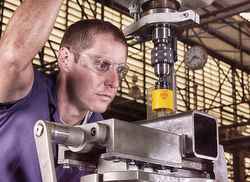
Posted to News on 17th May 2016, 14:49
Top three industrial trends in 2016
UK manufacturing has faced relatively uncertain times in recent years. The economic collapse of 2008 led to a hostile period of market instability, which coincided with a period of great technological growth - with few of these technologies being properly adopted due to costs. Almost a decade later, these advancements are at last becoming increasingly common in industrial sectors. John Cove, Marketing Manager of metrology and saw blade specialist Starrett, explores these current industry trends.

Technology is currently advancing at a rate never before seen and it is showing little sign of slowing down. Concepts that have existed for some time, such as additive manufacturing and big data, are now becoming commonplace and being used in new and innovative ways.
Starrett was excited to exhibit at this year's MACH trade show, alongside a number of other industry-leading businesses. The show not only demonstrated the ways that the industry is adjusting to new trends, but also the considerations that go into making these exciting concepts a reality.
Accuracy of big data
Big data in particular is becoming increasingly valuable to businesses. While the idea of accumulating and analysing large quantities of data from technological sources has been around since the turn of the century, it has taken us nearly a fifth of that to develop our infrastructure to a point where it can be used effectively.
Once analysed, this data can provide valuable insight into processes and can highlight areas for improvement. This is driving an industry requirement for precision measurement to ensure that data is accurate, which can be challenging in most manufacturing environments where time is of the essence and multiple tests are required to provide readings.
However, there has been progress on this front. Starrett's range of force measurement machines tackle this problem head on, using software developed to run multiple tests simultaneously for more accurate and immediate data. This can then be fed back to another device for analysis.
Additive manufacturing, not testing
One of the most prominent trends observed at 2016's industrial trade shows is that of new manufacturing techniques, particularly additive manufacturing. Initially, this process was used for quickly creating prototypes to offer a tangible insight into the end product, but in recent years we have seen this develop into a parts manufacturing process in its own right.
However, this new method of manufacturing is seeing businesses move away from conventional parts, creating challenges in terms of batch testing and measurement. As opposed to parts that fit the clean-cut shapes most measurement machines are designed for, additive manufacturing allows for more complex structures and shapes. It's not unusual now for parts to be designed in a hexagonal or even honeycomb shape, which prove difficult to submit for batch testing analysis.
Fortunately, the industry is adapting to this change. The software used by measurement devices is becoming increasingly successful at recognising and analysing challenging designs. Combining this with specialist technical knowledge allows businesses to ensure reliability and effectiveness in spite of these unconventional designs.
New materials and new challenges
Alongside the prospect of additive manufacturing, we're also seeing new and stronger materials being developed. Innovations such as graphene are providing manufacturers many opportunities to reinforce their existing surfaces with coatings of durable new materials, as well as to create entirely new structures.
These tougher surfaces are great selling points for manufacturers that make use of them, but they can become problematic further down the line. Contractors required to work on those materials may find difficulty in cutting through them, much in the same way that pre-existing surfaces made of materials including brickwork, masonry, plastic and wood, require specialist approaches.
As demonstrated at this year's trade shows, Starrett has developed a tool to address this dilemma. The new range of carbide-tipped hole saws is designed to run at higher drill speeds to cut through stronger and denser materials efficiently, with the carbide tips providing a deeper cut than standard steel tips.
As the UK continues on the path to economic recovery, the manufacturing sector is also progressing towards widespread adoption of these new technologies. If businesses continue to tackle the hurdles that may arise, it isn't beyond belief that we could even witness these innovations become commonplace in the next few years.
For more information about Starrett's products and services please visit www.starrett.co.uk.















